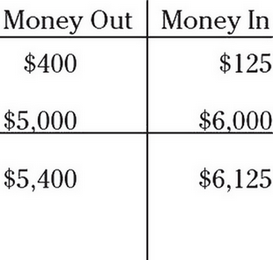Series 7 Exam Question 347: Answer and Explanation
Question: 347
Use the following exhibit to answer this question:
| TUV | Strike | May | Aug. | Nov. |
|---|---|---|---|---|
| 60.50 | 50 | 12 | 14.50 | 16 |
| 60.50 | 50p | a | 0.50 | 1.25 |
| 60.50 | 60 | 2 | 3.25 | 5 |
| 60.50 | 60p | 1.50 | 2.75 | 4 |
(p - put, a - not traded)
If an investor buys a TUV Nov 60 put and writes a TUV Nov 50 put, what is the maximum gain?
- A. $275
- B. $325
- C. $675
- D. $725
Correct Answer: D
Explanation:
D. The best way to determine the maximum gain is to set up an options chart. The first thing you need to do is find the premiums for the two options. Looking at the exhibit, you can see that the premium for the TUV Nov 60 put is 4 and the premium for the TUV Nov 50 put is 1.25. Because the investor purchased the 60 put, you have to put 400 (4 premium × 100 shares per option) on the "Money Out" side of the chart. Next, you have to put 125 (1.25 premium × 100 shares per option) on the "Money In" side of the chart because the investor sold that option. After doing that, you can see that you have $275 more in money out than money in, so that's the investor's maximum loss. To get the maximum gain, you have to exercise both options. Because "puts switch," you have to put the exercised strike price of $6,000 on the opposite side of its premium and the exercised strike price of $5,000 on the opposite side of its premium.

After totaling up the two sides, you can see that the maximum gain is $725, because there's $725 more money in than out.
Test Information
- Use your browser's back button to return to your test results.
- Do more Series 7 Exam Practice Tests tests.
More Tests
- Series 7 Exam Practice Test 1
- Series 7 Exam Practice Test 2
- Series 7 Exam Practice Test 3
- Series 7 Exam Practice Test 4
- Series 7 Exam Practice Test 5
- Series 7 Exam Practice Test 6
- Series 7 Exam Practice Test 7
- Series 7 Exam Practice Test 8
- Series 7 Exam Practice Test 9
- Series 7 Exam Practice Test 10
- Series 7 Exam Practice Test 11
- Series 7 Exam Practice Test 12